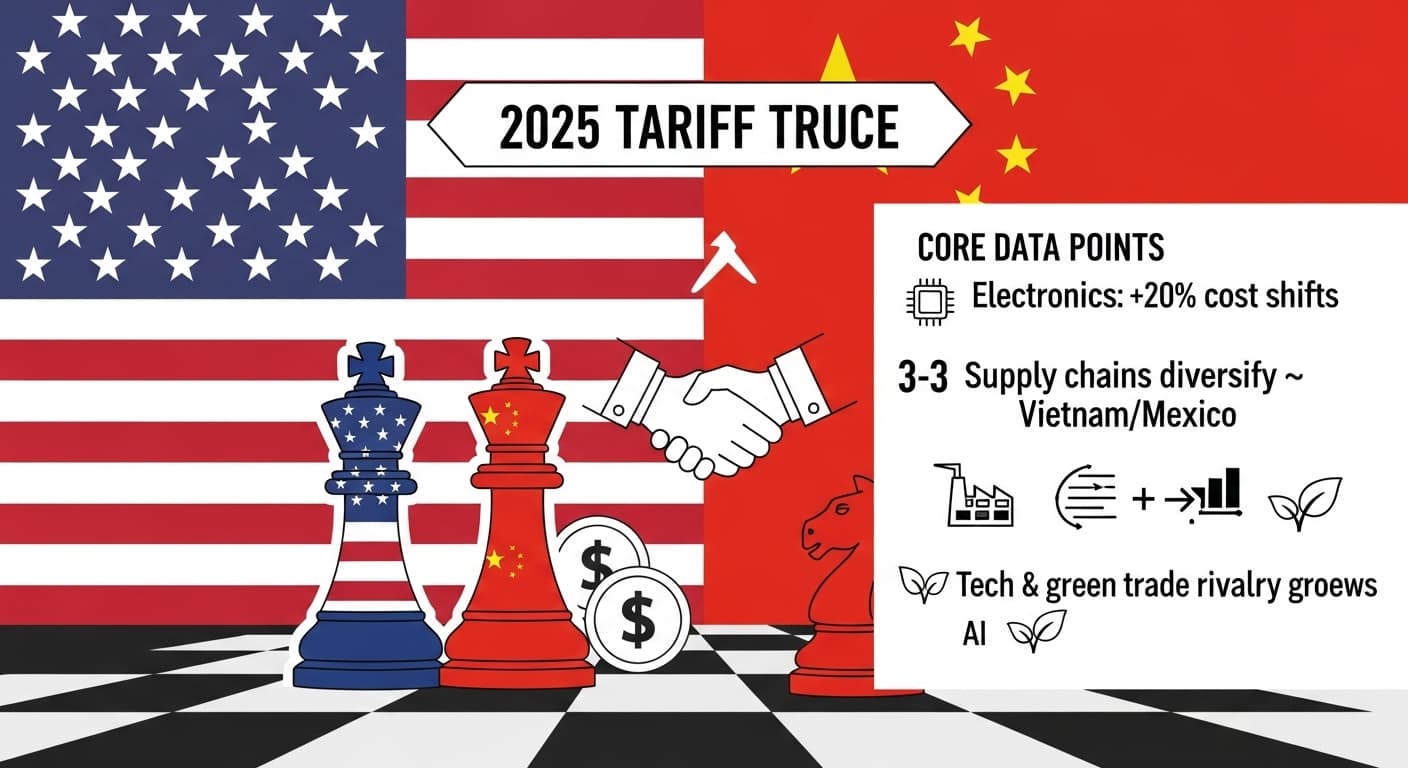
Executive Summary
The ongoing dynamics of U.S.-China trade relations continue to create significant uncertainty for global businesses engaged in international commerce. Understanding the negotiation processes, policy implications, and strategic responses is essential for organizations managing complex international supply chains and market relationships during periods of trade policy volatility.
Navigating U.S.-China Trade Relations: Strategic Analysis and Business Implications
(美中关税休战:宏观观察与实务对策)
1 · Understanding the Complex Landscape of U.S.-China Trade Relations
The relationship between the United States and China represents one of the most significant and complex economic relationships in the global economy. The evolution of trade policies between these two economic powers has far-reaching implications for businesses, consumers, and the broader international trading system.
Historical Context and Evolution
Trade Relationship Development: The U.S.-China trade relationship has evolved dramatically over the past several decades, reflecting changing economic priorities, geopolitical considerations, and domestic political pressures:
Early Engagement Era (1980s-2000s):
- Market Opening: China’s gradual integration into the global trading system
- Most Favored Nation Status: Evolution of trade preferences and market access
- Economic Growth: Rapid expansion of bilateral trade volumes and economic interdependence
- Supply Chain Integration: Development of complex, integrated manufacturing and supply networks
Trade Tension Emergence (2010s):
- Trade Imbalance Concerns: Growing awareness of bilateral trade deficit issues
- Intellectual Property Issues: Increasing focus on technology transfer and IP protection
- Market Access Barriers: Concerns about reciprocal market access and competitive fairness
- Strategic Competition: Recognition of broader strategic competition between economic systems
Current Policy Environment:
- Tariff Implementation: Use of tariffs as policy tool for addressing trade concerns
- Technology Restrictions: Enhanced scrutiny of technology transfer and national security implications
- Supply Chain Security: Focus on critical supply chain resilience and diversification
- Economic Decoupling Discussions: Debates about appropriate levels of economic interdependence
Negotiation Dynamics and Policy Frameworks
Multi-Level Negotiation Complexity: Trade negotiations between major economies involve multiple stakeholders and complex interdependencies:
Government Stakeholders:
- Executive Branch: Presidential authority and administrative agency coordination
- Legislative Oversight: Congressional involvement in trade policy development and approval
- Regulatory Agencies: Specialized agency expertise in technical and compliance issues
- State and Local Governments: Regional economic interests and implementation considerations
Business Community Involvement:
- Industry Associations: Sectoral representation and advocacy for specific business interests
- Individual Companies: Direct engagement and lobbying on specific trade issues
- Supply Chain Partners: Coordination among interconnected business relationships
- Professional Service Providers: Legal, consulting, and advisory services supporting negotiation processes
International Considerations:
- Multilateral Trade Framework: WTO rules and international trade law obligations
- Third-Country Impacts: Effects on other trading partners and global supply chains
- Regional Trade Agreements: Interaction with other bilateral and multilateral trade relationships
- Global Economic Stability: Broader implications for international economic stability
2 · Economic Impact Analysis and Market Implications
Understanding the economic implications of trade policy changes requires comprehensive analysis across multiple dimensions and stakeholder groups.
Macroeconomic Effects and Market Dynamics
Trade Flow Analysis: Changes in trade policies create ripple effects throughout the global economy:
Import and Export Patterns:
- Volume Effects: Changes in trade volumes affecting production and consumption patterns
- Price Impacts: Cost changes affecting consumer prices and business profitability
- Market Share Shifts: Competitive rebalancing among suppliers and markets
- Investment Flows: Capital allocation changes responding to new trade conditions
Currency and Financial Market Implications:
- Exchange Rate Effects: Currency movements reflecting trade balance changes and market expectations
- Capital Market Reactions: Stock market and bond market responses to trade policy developments
- Investment Confidence: Business investment decisions affected by policy uncertainty
- Risk Premiums: Changes in risk assessment and pricing for international transactions
Regional Economic Impacts:
- Geographic Distribution: Varying effects across different regions and economic centers
- Industrial Concentration: Sector-specific impacts based on trade exposure and competitive position
- Employment Effects: Labor market implications across different industries and skill levels
- Infrastructure Utilization: Changes in transportation and logistics infrastructure usage
Sectoral Analysis and Industry-Specific Implications
Manufacturing Industries: Different manufacturing sectors face varying degrees of exposure to trade policy changes:
Electronics and Technology:
- Supply Chain Complexity: Highly integrated global supply chains with multiple country involvement
- Technology Transfer Issues: Enhanced scrutiny of technology sharing and intellectual property
- Market Access Concerns: Reciprocal market access and competitive fairness issues
- Innovation Competition: Competition in emerging technology areas and standard-setting
Automotive Industry:
- Integrated Production: Complex supply chains spanning multiple countries and jurisdictions
- Regulatory Harmonization: Technical standards and safety regulation coordination
- Electric Vehicle Transition: Competition in emerging clean technology markets
- Trade Agreement Impacts: Regional trade agreement effects on production location decisions
Textile and Apparel:
- Cost Sensitivity: High sensitivity to cost changes from tariffs and trade restrictions
- Supply Chain Flexibility: Ability to adjust sourcing locations and production strategies
- Labor Standards: Increasing focus on labor practices and social responsibility
- Market Access: Consumer market access and brand positioning considerations
Agricultural Products:
- Commodity Markets: Price volatility and market access for agricultural commodities
- Food Security: National food security considerations and agricultural policy coordination
- Environmental Standards: Sustainability and environmental regulation harmonization
- Rural Economic Impact: Effects on rural communities and agricultural regions
Consumer and Business Cost Analysis
Consumer Price Effects: Trade policy changes ultimately affect consumer prices and purchasing power:
Direct Price Impacts:
- Tariff Pass-Through: Extent to which tariffs are reflected in consumer prices
- Product Substitution: Consumer adaptation to price changes through product switching
- Quality Adjustments: Changes in product quality and features in response to cost pressures
- Market Competition: Competitive dynamics affecting pricing strategies and market positioning
Business Cost Structure Changes:
- Input Cost Variations: Changes in raw material and component costs
- Supply Chain Adjustments: Costs associated with supply chain reconfiguration and diversification
- Compliance Requirements: Administrative and compliance costs from changing regulations
- Risk Management: Costs of managing increased uncertainty and volatility
3 · Strategic Response Framework for International Businesses
Organizations engaged in international trade must develop comprehensive strategies for managing trade policy uncertainty while maintaining competitive positioning and operational effectiveness.
Risk Assessment and Management
Comprehensive Risk Evaluation: Effective trade policy risk management requires systematic assessment across multiple dimensions:
Policy Risk Categories:
- Regulatory Changes: Potential for new tariffs, trade restrictions, and compliance requirements
- Market Access Risks: Changes in market access conditions and competitive fairness
- Supply Chain Disruption: Potential for supply chain interruption and reconfiguration needs
- Financial Exposure: Currency, pricing, and profitability risks from policy changes
Risk Assessment Methodologies:
- Scenario Analysis: Development of multiple potential policy scenarios and their business implications
- Sensitivity Analysis: Understanding business sensitivity to various types and magnitudes of policy changes
- Probability Assessment: Evaluation of likelihood of different policy outcomes and their timing
- Impact Quantification: Financial and operational impact modeling for different risk scenarios
Risk Monitoring Systems:
- Policy Intelligence: Systematic tracking of policy developments and negotiation progress
- Market Indicators: Monitoring of economic and market indicators reflecting policy expectations
- Stakeholder Insights: Engagement with government officials, industry associations, and policy experts
- Early Warning Systems: Development of indicators and triggers for proactive response activation
Supply Chain Strategy and Diversification
Strategic Supply Chain Planning: Organizations must balance efficiency with resilience in supply chain design:
Geographic Diversification:
- Multi-Country Sourcing: Development of supplier relationships across multiple countries and regions
- Production Flexibility: Manufacturing capabilities that can adapt to changing trade conditions
- Market Hedging: Balancing exposure across different markets and regulatory environments
- Risk Distribution: Spreading operational risk across diverse geographic and political environments
Supplier Relationship Management:
- Strategic Partnerships: Deep relationships with key suppliers enabling collaborative planning and risk management
- Supplier Development: Investment in supplier capabilities and resilience across multiple locations
- Alternative Sourcing: Qualified backup suppliers and alternative sourcing strategies
- Contractual Flexibility: Contract terms that accommodate changing trade conditions and requirements
Inventory and Working Capital Strategy:
- Strategic Stockpiling: Inventory positioning to manage potential supply disruptions
- Financial Planning: Working capital management for changing cost structures and cash flow patterns
- Hedging Strategies: Financial instruments for managing currency and commodity price risks
- Liquidity Management: Maintaining financial flexibility for rapid response to changing conditions
Market Strategy and Customer Relations
Market Positioning and Competitive Strategy:
- Value Proposition Adaptation: Adjusting product and service offerings to maintain competitiveness
- Pricing Strategy: Dynamic pricing approaches that reflect changing cost structures
- Market Diversification: Geographic and segment diversification to reduce market concentration risk
- Brand Positioning: Maintaining brand strength and customer loyalty during periods of uncertainty
Customer Communication and Relationship Management:
- Transparency: Open communication about potential impacts and company response strategies
- Service Continuity: Maintaining service levels and customer satisfaction during transitions
- Partnership Development: Strengthening customer relationships through collaborative planning and support
- Value Demonstration: Clear communication of value delivered despite changing market conditions
4 · Financial Management and Risk Mitigation Strategies
Managing the financial implications of trade policy uncertainty requires sophisticated financial planning and risk management approaches.
Financial Risk Management
Currency and Exchange Rate Management: International businesses face significant currency exposure during periods of trade policy uncertainty:
Hedging Strategies:
- Forward Contracts: Locking in exchange rates for future transactions
- Options Strategies: Flexible hedging approaches providing downside protection with upside participation
- Natural Hedging: Balancing currency exposures through operational structure and geographic positioning
- Dynamic Hedging: Adaptive hedging strategies that adjust to changing market conditions and policy expectations
Cost Structure Management:
- Variable Cost Optimization: Adjusting variable cost structures to maintain profitability under different scenarios
- Fixed Cost Flexibility: Maintaining operational flexibility to adjust fixed costs as conditions change
- Pricing Models: Dynamic pricing models that reflect changing cost structures and market conditions
- Profitability Analysis: Comprehensive analysis of profitability across different products, markets, and scenarios
Investment and Capital Allocation
Strategic Investment Planning:
- Capital Allocation: Strategic allocation of capital considering policy uncertainty and potential scenarios
- Investment Timing: Optimal timing of major investments considering policy development timelines
- Geographic Investment: Regional investment strategies balancing market access with operational efficiency
- Technology Investment: Investment in technology and automation to improve competitiveness and flexibility
Financial Flexibility and Liquidity:
- Credit Facilities: Maintaining adequate credit facilities for operational flexibility and emergency response
- Cash Management: Optimal cash positioning across multiple currencies and jurisdictions
- Working Capital Optimization: Efficient working capital management minimizing financial exposure
- Debt Structure: Appropriate debt structure considering currency exposure and refinancing risks
5 · Case Studies in Strategic Adaptation
Understanding how different organizations have successfully navigated trade policy uncertainty provides valuable insights for strategic planning and implementation.
Case Study 1: Global Electronics Manufacturer
Company Profile: Large multinational electronics manufacturer with complex global supply chain spanning multiple countries and product categories
Trade Policy Challenges: The company faced potential significant tariff increases on key product categories, technology transfer restrictions, and supply chain security requirements affecting core business operations.
Strategic Response Framework:
Supply Chain Diversification Initiative:
- Geographic Rebalancing: Systematic evaluation and rebalancing of production across multiple countries
- Supplier Development: Investment in supplier capabilities across diverse geographic regions
- Technology Localization: Development of regional technology and production capabilities
- Risk Assessment: Comprehensive assessment of supply chain vulnerabilities and mitigation strategies
Market Strategy Adaptation:
- Product Portfolio Optimization: Adjustment of product mix considering trade policy implications
- Pricing Strategy Evolution: Dynamic pricing strategies reflecting changing cost structures
- Customer Communication: Proactive communication with customers about potential impacts and mitigation strategies
- Service Enhancement: Investment in service capabilities to maintain competitive differentiation
Financial Risk Management:
- Currency Hedging: Comprehensive currency hedging program managing exchange rate exposure
- Cost Structure Optimization: Systematic cost structure analysis and optimization
- Investment Prioritization: Strategic prioritization of investments considering policy uncertainty
- Liquidity Management: Enhanced liquidity management for operational flexibility
Results and Outcomes:
- Supply Chain Resilience: Successfully maintained production continuity despite policy changes
- Market Position: Preserved market share and customer relationships through transition period
- Financial Performance: Managed cost impacts while maintaining profitability targets
- Competitive Advantage: Gained competitive advantage through superior adaptation and customer service
Case Study 2: Consumer Goods Retailer and Brand Portfolio
Company Profile: Large retailer with extensive private label program and diverse supplier base primarily located in Asia
Challenge Context: The company faced potential significant cost increases across major product categories, requiring comprehensive strategy for managing consumer price impacts while maintaining market competitiveness.
Comprehensive Response Strategy:
Sourcing Strategy Transformation:
- Geographic Diversification: Systematic diversification of sourcing across multiple countries and regions
- Supplier Partnership Development: Deep partnerships with suppliers for collaborative risk management
- Product Design Optimization: Product design changes to optimize cost structures under new trade conditions
- Quality Assurance: Enhanced quality assurance systems across diverse supplier base
Inventory and Financial Management:
- Strategic Inventory Positioning: Inventory positioning strategy balancing cost management with service levels
- Working Capital Optimization: Enhanced working capital management for changing cost structures
- Pricing Strategy: Systematic pricing strategy balancing cost recovery with market competitiveness
- Financial Planning: Comprehensive financial planning for multiple policy scenarios
Customer and Market Strategy:
- Value Communication: Clear communication to customers about value proposition during transition
- Product Mix Optimization: Strategic optimization of product mix considering cost and margin implications
- Market Positioning: Adaptation of market positioning to maintain competitive advantage
- Service Enhancement: Investment in customer service and experience to maintain loyalty
Performance Outcomes:
- Cost Management: Successfully managed cost increases while maintaining competitive pricing
- Supply Chain Resilience: Built more resilient and diversified supply chain
- Market Share: Maintained market share and customer satisfaction during transition
- Financial Results: Achieved financial targets despite challenging operating environment
Case Study 3: Industrial Manufacturing Company
Company Profile: Mid-size industrial manufacturer serving B2B markets with specialized products and long-term customer relationships
Strategic Challenge: The company needed to manage potential cost increases while maintaining long-term customer relationships and service commitments in a highly competitive industrial market.
Tailored Response Approach:
Customer Partnership Strategy:
- Collaborative Planning: Deep collaboration with key customers on cost management and risk sharing
- Contract Renegotiation: Systematic renegotiation of contracts to accommodate changing cost structures
- Value-Added Services: Enhancement of value-added services to strengthen customer relationships
- Joint Problem-Solving: Collaborative approach to problem-solving and cost optimization
Operational Optimization:
- Process Improvement: Systematic process improvement to offset cost increases through efficiency gains
- Technology Investment: Strategic technology investment to improve productivity and competitiveness
- Quality Enhancement: Quality improvement initiatives reducing costs and enhancing customer value
- Lean Manufacturing: Implementation of lean manufacturing principles for waste reduction and efficiency
Supply Chain Strategy:
- Supplier Collaboration: Deep collaboration with suppliers for mutual cost optimization
- Alternative Sourcing: Development of alternative sourcing options for risk mitigation
- Inventory Optimization: Enhanced inventory management balancing costs with service requirements
- Logistics Efficiency: Optimization of logistics and distribution for cost and service improvement
Strategic Results:
- Customer Retention: Maintained key customer relationships through collaborative approach
- Cost Competitiveness: Achieved cost competitiveness through operational improvements
- Market Position: Strengthened market position through enhanced value proposition
- Financial Performance: Maintained profitability and financial stability during challenging period
6 · Policy Analysis and Future Considerations
Understanding the broader policy context and potential future developments enables better strategic planning and risk management.
Trade Policy Development Trends
Multilateral vs. Bilateral Approaches: The evolution of international trade policy reflects tension between multilateral cooperation and bilateral negotiation:
Multilateral Framework Evolution:
- WTO Reform: Ongoing discussions about World Trade Organization modernization and effectiveness
- Regional Trade Agreements: Development of comprehensive regional trade partnerships
- Sectoral Agreements: Specialized agreements addressing specific industries or issues
- Standards Harmonization: International cooperation on technical standards and regulatory approaches
Bilateral Relationship Management:
- Strategic Competition: Managing trade relationships within broader strategic competition context
- Economic Interdependence: Balancing economic integration with national security considerations
- Reciprocity Principles: Emphasis on reciprocal market access and competitive fairness
- Issue Linkage: Connection between trade issues and broader diplomatic and security relationships
Technology and Innovation Policy Integration
Technology Competition and Cooperation: Trade policy increasingly intersects with technology policy and innovation competition:
Intellectual Property Protection:
- Patent System Harmonization: International cooperation on patent protection and enforcement
- Technology Transfer Regulations: Rules governing technology sharing and licensing
- Trade Secret Protection: Enhanced protection for confidential business information
- Innovation Incentives: Policy frameworks supporting innovation while enabling fair competition
Digital Trade and E-commerce:
- Data Governance: International frameworks for data protection and cross-border data flows
- Digital Platform Regulation: Regulation of digital marketplaces and platform businesses
- Cybersecurity Standards: International cooperation on cybersecurity standards and practices
- Digital Infrastructure: Investment in and access to digital infrastructure and capabilities
Environmental and Sustainability Integration
Trade and Environmental Policy Convergence: Environmental considerations are increasingly integrated into trade policy discussions:
Carbon Border Adjustments:
- Climate Policy Integration: Integration of climate policy with trade rules and agreements
- Carbon Pricing Mechanisms: International coordination on carbon pricing and border adjustments
- Clean Technology Trade: Facilitation of clean technology transfer and deployment
- Environmental Standards: Harmonization of environmental standards and regulations
Sustainable Supply Chain Requirements:
- Environmental Due Diligence: Requirements for environmental impact assessment and mitigation
- Social Responsibility Standards: Integration of labor and human rights standards into trade agreements
- Circular Economy Principles: Trade rules supporting circular economy and waste reduction
- Sustainable Development Goals: Integration of UN Sustainable Development Goals into trade policy
7 · Strategic Planning Framework for Trade Policy Uncertainty
Organizations must develop systematic approaches for strategic planning under conditions of ongoing trade policy uncertainty.
Scenario Planning and Strategic Flexibility
Comprehensive Scenario Development: Effective strategic planning requires consideration of multiple potential policy outcomes:
Policy Scenario Categories:
- Cooperation Scenarios: Outcomes involving enhanced trade cooperation and agreement
- Competition Scenarios: Outcomes involving continued or escalated trade tensions
- Decoupling Scenarios: Outcomes involving significant reduction in economic integration
- Hybrid Scenarios: Mixed outcomes with cooperation in some areas and competition in others
Business Impact Assessment:
- Financial Modeling: Quantitative analysis of financial impacts under different scenarios
- Operational Requirements: Operational changes and investments required for different outcomes
- Market Implications: Market share and competitive position effects under various scenarios
- Strategic Options: Strategic options and flexibility available under different conditions
Adaptive Planning Approaches:
- Flexible Strategy Design: Strategic approaches that can adapt to changing conditions
- Option Value Creation: Investment in capabilities that create options for future adaptation
- Milestone Planning: Planning approaches with decision points based on policy developments
- Contingency Preparation: Preparation for rapid implementation of alternative strategies
Organizational Capabilities and Change Management
Building Organizational Resilience: Organizations must develop internal capabilities for managing ongoing uncertainty and change:
Strategic Capabilities:
- Policy Intelligence: Capabilities for monitoring and analyzing policy developments
- Scenario Planning: Skills and processes for effective scenario planning and analysis
- Strategic Agility: Organizational ability to quickly adapt strategies and operations
- Risk Management: Comprehensive risk management capabilities across multiple dimensions
Operational Flexibility:
- Supply Chain Adaptability: Supply chain capabilities that can adjust to changing conditions
- Production Flexibility: Manufacturing and production systems that can adapt to new requirements
- Market Agility: Marketing and sales capabilities that can respond to changing market conditions
- Financial Flexibility: Financial management capabilities supporting rapid adaptation
Organizational Learning:
- Knowledge Management: Systems for capturing and sharing lessons learned from policy changes
- Best Practice Development: Development and sharing of best practices for managing uncertainty
- Innovation Culture: Organizational culture supporting innovation and adaptation
- Change Management: Capabilities for managing organizational change and transformation
8 · Industry Collaboration and Stakeholder Engagement
Effective management of trade policy uncertainty often requires collaboration across industry boundaries and active engagement with multiple stakeholder groups.
Industry Association and Collective Action
Trade Association Engagement: Industry associations play crucial roles in policy advocacy and information sharing:
Policy Advocacy:
- Position Development: Collaborative development of industry positions on trade policy issues
- Government Relations: Professional representation of industry interests to government officials
- Coalition Building: Building coalitions across industries and stakeholder groups
- Policy Impact Analysis: Comprehensive analysis of policy impacts across industry sectors
Information Sharing and Best Practices:
- Market Intelligence: Sharing of market intelligence and policy analysis across members
- Best Practice Development: Collaborative development of best practices for managing policy uncertainty
- Training and Education: Educational programs helping members understand and adapt to policy changes
- Networking and Collaboration: Platforms for networking and collaboration among industry participants
Government Relations and Public Policy Engagement
Proactive Government Engagement: Organizations benefit from proactive engagement with government officials and policy makers:
Policy Communication:
- Business Impact Communication: Clear communication of business impacts from policy changes
- Technical Expertise: Sharing of technical and industry expertise to inform policy development
- Implementation Feedback: Feedback on practical implementation challenges and solutions
- Long-term Perspective: Communication of long-term industry and economic implications
Regulatory Compliance and Coordination:
- Compliance Excellence: Demonstration of commitment to regulatory compliance and cooperation
- Process Improvement: Collaboration on improving regulatory processes and effectiveness
- Innovation Support: Support for policy innovation and experimentation
- International Coordination: Support for international regulatory cooperation and harmonization
Supply Chain Partner Collaboration
Ecosystem-Wide Collaboration: Managing trade policy uncertainty requires collaboration across entire supply chain ecosystems:
Supplier Partnerships:
- Risk Sharing: Collaborative approaches to sharing and managing trade policy risks
- Joint Planning: Collaborative planning for adapting to changing trade conditions
- Information Sharing: Open communication about policy impacts and adaptation strategies
- Capability Development: Joint investment in capabilities supporting policy adaptation
Customer Collaboration:
- Transparency: Open communication with customers about policy impacts and response strategies
- Joint Problem-Solving: Collaborative approaches to managing cost and service impacts
- Value Creation: Joint identification of opportunities for value creation despite policy challenges
- Long-term Partnership: Strengthening long-term partnerships through collaborative adaptation
9 · Conclusion and Strategic Recommendations
Key Strategic Insights
Dynamic Policy Environment: The ongoing evolution of U.S.-China trade relations reflects broader trends in international economic policy and strategic competition. Organizations must prepare for continued volatility and uncertainty while building capabilities for effective adaptation.
Strategic Opportunity Recognition: While trade policy uncertainty creates challenges, it also creates opportunities for organizations that can effectively adapt and differentiate themselves through superior strategic planning and execution.
Stakeholder Collaboration Imperative: Success in managing trade policy uncertainty increasingly requires effective collaboration across industry boundaries, supply chain partnerships, and government relations.
Recommendations for Strategic Action
Immediate Priorities:
- Risk Assessment: Comprehensive assessment of trade policy exposure and vulnerability
- Scenario Planning: Development of multiple scenarios and contingency plans
- Stakeholder Engagement: Proactive engagement with industry associations, government relations, and supply chain partners
- Capability Building: Investment in organizational capabilities for managing uncertainty and change
Medium-Term Strategy Development:
- Supply Chain Diversification: Systematic diversification of supply sources and market exposure
- Financial Risk Management: Enhanced financial risk management and hedging strategies
- Market Positioning: Strategic positioning for competitive advantage during periods of uncertainty
- Technology Investment: Investment in technology and automation supporting flexibility and competitiveness
Long-Term Strategic Positioning:
- Competitive Differentiation: Building sustainable competitive advantages through superior adaptation capabilities
- Market Leadership: Establishing leadership positions in key markets and technology areas
- Ecosystem Development: Building and leading resilient supply chain ecosystems
- Innovation Leadership: Maintaining innovation leadership despite challenging operating conditions
Final Considerations
The complexity and importance of U.S.-China trade relations require sophisticated understanding and strategic response from organizations engaged in international commerce. Success requires balancing multiple considerations including cost efficiency, risk management, competitive positioning, and stakeholder relationships.
Organizations that approach these challenges strategically, with comprehensive planning and systematic execution, will be better positioned not only to manage current uncertainties but to capture opportunities for long-term growth and competitive advantage. The key is building adaptive capabilities that can respond effectively to changing conditions while maintaining focus on fundamental business objectives and stakeholder value creation.
The future of international trade will be shaped by how effectively businesses, governments, and other stakeholders can collaborate to manage these complex relationships while promoting economic growth, innovation, and mutual prosperity.
This analysis provides comprehensive information about U.S.-China trade relations and their strategic implications for international businesses. Organizations seeking to develop specific strategies for managing trade policy uncertainty or optimize their international operations may benefit from professional consultation with experienced international trade and strategy practitioners who can provide guidance tailored to specific industry sectors and operational requirements.


